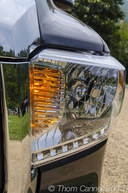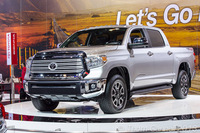2014 Toyota Tundra Thom Cannell First Look
By Thom Cannell
Senior Editor
Michigan Bureau
The Auto Channel
Toyota’s 2014 Tundra is more a reboot than an all-new app. The best of existing Tundra genetic code: engines, chassis and suspension are retained or revised with the lightest of touches while the internal and external appearance is recombined and recoded. Mostly for the better.
Tundra is a recent invention, the first 3/4 sized T150 / Tundra emerging in 2000 and the full-sized version launched in 2007, followed by a CrewMax crew cab, also in 2007. In 2009 E85 capability was added to the 5.7-liter engine, so Toyota has been enhancing their gene pool. The biggest change since then have been additional electronics like Trailer Sway Control plus a change in the navigation system in 2011. In 2013 the Platinum Package, introduced in 2010, became a model grade and for 2014 there is a new super-premium 1794 model that tackles high zoot trucks like Ford’s King Ranch. Well known models like SR/ Work Truck, volume leader SR5, Limited, and TRD Off-Road complete the lineup.
While it’s hard to imagine, Toyota is positioning Tundra as a value leader: comparing 2013 to 2014, there’s an average $263 reduction in price even though every Ten Best rates Tundra as tough, available in 4x2 and 4x4, and equipped with every bed size or number of passenger seats you could wish for.
 |
What has been changed is suspensions, the front double wishbone springs are stiffer and the dampers retuned. At the rear, dampers are retuned and friction reduced. No other changes were deemed necessary. Oh, cabs? Still the whole suite of regular cab, double cab, and CrewMax remains untouched.
 |
 |
A trick that they’ve added, or we’ve missed, is ability to level headlights, which is great when the bed is loaded or if towing. That joins the backup camera, blind spot monitoring, and parking assists as options.
 |
As the base model (all were preproduction models), it had solid rubber floor mats with carpet beneath, though that wouldn't matter a scrap to most potential buyers, and charcoal black cloth interior. Lets start with the seats, done in an attractive and surely durable dimensional woven cloth. Back seats were sufficiently large for any passengers with carpet underfoot. But, as we dragged mud and debris into the cabin, the mats were all we cared about.
Another feature that has some echoes elsewhere in the industry is a fold-down center console that, when snapped upright, makes a third front seat. Perhaps Toyota is run by romantics who remember having their sweetheart sitting beside, but this time there are seat belts the better to hold them closer. When in divided mode the seat back becomes a storage container with dual cup holder and a driver's side flashlight-sized bin. A larger lunch-box sized box is inset East-West that can be used by any passenger. Oh, the center seat cushion hinges forward to reveal a laptop-plus-binder sized bin. Slick.
 |
There was no time in our day to whomp and stomp the Tundra through fields of mud and stone, only some dirt roads where it rode with confidence. Near as we can figure, there is no significant change to the chassis since 2010 other than dampers re-valved for better control. Tundra rear springs are still trapezoidally attached, where others are more linear. Toyota thinks this offers better lateral control. We can't say, though Toyota also has some convincing data that its half-ton plays with even bigger kids on nearly equal footing.
Regardless your choice in options and adornments, Tundra offers standard 6.5’, short 5.5’, and a double cab with 8.1’ long bed. So let's talk about the one thing I'd swap right now, the steering gear. Toyota says its electronic power steering (EPAS) has been tightened through revised computer instructions. We think it should be tighter, you know, squeezing a brick of aged Vermont cheddar instead of Velveeta. Right now there’s too much just-off-center rubberiness.
Toyota has sold over one million Tundras, designed in California and engineered in Michigan, and since 2008 all have been built in Texas. While no one expects Tundra to overtake Ram, F-150, or Silverado, it now presents a better face to compete against those stalwarts.



